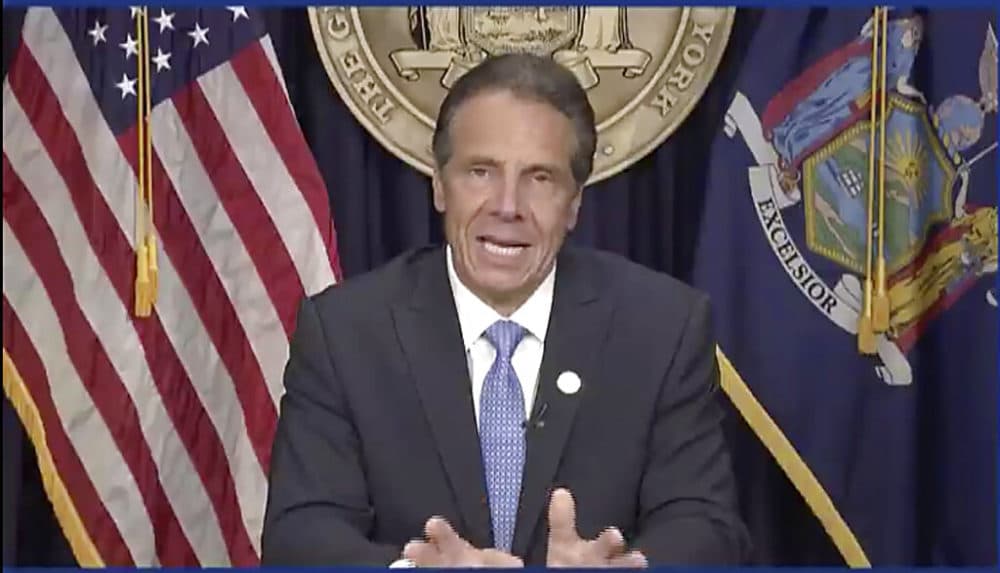Advertisement
Commentary
Andrew Cuomo Finally Resigned But He Still Doesn't Get It

Some years ago, before the E-ZPass era, I was driving west on the Mass Pike Extension and arrived at the old Weston Plaza tollbooth. I handed two dollar bills to the collector, a bearded, middle-aged white man, and said, “Hi, how are you?” He said hi back. Then, rather than dropping the change into my cupped palm, he slowly, deliberately swiped one finger along my palm, from my wrist to my fingertips, then let the change fall.
I still cringe when I recall that unexpected gesture — the lingering sensation of his fingernail made an indelible groove in my consciousness.
That memory arose last week in the wake of New York Attorney General Letitia James’s report detailing the findings of an investigation into sexual harassment and sexual assault allegations by 11 women against Gov. Andrew Cuomo.
By now, we’ve all seen that initial “denial” speech, including the slick, campaign-esque montage of him hugging and kissing friends, co-workers and strangers alike. He said casually, “I do it with everyone.”
Sadly, in his resignation speech, he remained tone-deaf. Even though he offered words such as “thoughtless" and “mistake,” and apologized, claiming “full responsibility,” he also continued to downplay the seriousness of the women’s reports — citing “generational” insensitivity and blaming others for misinterpreting his well-meaning, affectionate habit. That habit, he said, is “my way of saying I see you, I appreciate you, I thank you.” Simply masterful gaslighting.
[T]he scars of intrusion live on in the cells and the psyche of the victim, invisible and often unacknowledged.
Every time these cases come to public light, I am reminded of not just the toll collector’s swipe but of countless instances of unwanted touch — a male friend of my parents’ would pinch my “cute little tushy” as a child; a male relative would press too tightly during a hello hug; a male hotel elevator operator kissed me on the mouth when I was 8; a strange man’s arm brushed against my chest on the T, on more than one occasion. The list goes on. And I know I’m not alone, as evidenced by the thousands of other #MeToo women, and men, who have shared their truth.
I’m talking about creepy touch. So-called “nonviolent” touch. Insidious touch. These personal violations aren't equivalent to an assault such as rape, of course. Nevertheless, the scars of intrusion live on in the cells and the psyche of the victim, invisible and often unacknowledged.
Creepy touch is visceral and unsettling. One of Cuomo’s complainants, a young, female state trooper, was assigned to protect him. According to the report, during one elevator ride, “the Governor placed his finger on the top of her neck and ran his finger down the center of her spine midway down her back, and said . . . ‘Hey, you.’”
Advertisement
Even if victims of creepy touch never say a word about it (“I didn’t report it,” “I didn’t stop it,” “I didn’t know what to do,” “I froze,” “I didn’t want to lose my job,” “I was ashamed”), their felt experience is real.
Bottom line: The perpetrator doesn’t get to define the quality of the touch. The only one who gets to decide whether a touch is wanted or unwanted is the person being touched. Trauma expert Dr. Bessel van der Kolk captured this concept beautifully in the title of his well-known book, "The Body Keeps the Score."
Even kindergarteners know what 'uh-oh' feels like in their bodies.
The trooper wasn’t the only Cuomo accuser to use the word “creepy” in her testimony. Since then, a criminal complaint filed by another staffer, “Executive Assistant #1,” identified as Brittany Commisso, notes an incident at the governor’s mansion in which Cuomo allegedly reached under her blouse and grabbed her breast, among other alleged violations she has now discussed publicly. Legally speaking, this was more than creepy touch, which itself can be considered criminal in certain workplace settings. This was criminal sexual assault.
By minimizing and normalizing his actions, Cuomo seemed to be saying, "Sexual harassment? Sexual assault? What are you talking about? I’m just a touchy-feely guy. I intended no harm." He went on to insist that he “never touched anyone inappropriately” or “made inappropriate sexual advances.” Upon his resignation, he twisted this dodge impressively with, “In my mind, I’ve never crossed the line with anyone, but I didn’t realize the extent to which the line has been redrawn.”
These tropes are so familiar in our culture by now, they're almost laughable. But Cuomo was eviscerated in the media and the N.Y. State Assembly was preparing for impeachment proceedings if he didn’t resign.
More from WBUR
As a volunteer with a child abuse prevention program, I teach (or did, pre-pandemic) elementary school kids the difference between safe and unsafe touch with a person the child knows. Kids learn about force and coercion, and also that one indicator of whether touch is safe or unsafe is how the child feels inside. Do they feel comfortable? Relaxed? Happy? Or do they sense something is off? Wrong? Weird? If it’s the latter, we call it an “uh-oh” feeling. Even kindergarteners know what “uh-oh” feels like in their bodies.
Consensual touch feels safe. Creepy touch does not.
I applaud the 11 women for coming forward, especially to disclose those subtler, but still damaging, incidents of unwanted touch. Rather than focusing on those who say, “In my mind, I did nothing wrong,” perhaps now we can listen more closely to those who say, “In my mind and body, I knew something was wrong.”
